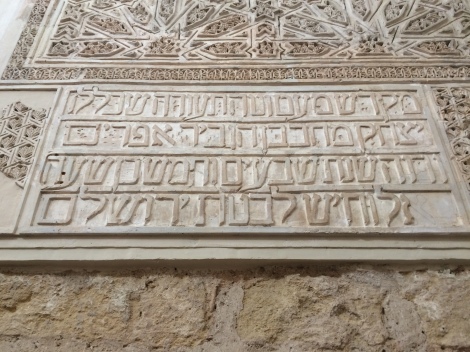
Roman Bridge Into Cordoba
Sephardic Jewry began in Cordoba. Cordoba was the seat of the Spanish Caliphate. It therefore was a major centre of Jewish life in early Muslim Andalusia, and it remained so until the Almohads arrived and drove them out in 1148. While Jewish life returned to Andalusia during the Christian era, it is the early period that captures the memory of Sephardic origins. The foundation story of Sephardic Jewry (“The Four Captives”) centres around Cordoba, as told in the 12th century by Abraham ibn Daud in his Sefer ha-Qabbalah.

‘The Four Captives’ at Cordoba Jewish Museum
Significantly, the 10th century Muslim Said al-Andalusia records that the Cordoban sage Hasdai ibn Shaprut led a movement to make Sephardic Jewry independent of the Geonate in Babylonia (likely a mirror of the recently independent Caliphate of Cordoba).

Cordoba, Spain
I was therefore elated as I arrived in Cordoba. Indeed, not only is Cordoba the birthplace of the Iberian Sephardim, in many ways it is the birthplace of Diaspora Sephardic Jewry. No figure is more associated with Sephardim than the great Maimonides, the towering legalist, philosopher, communal leader and doctor. He was born in Cordoba. While he fled Spain with his family to escape the invading Almohads in 1148 , amazingly, he continued to sign his name ‘Moshe the Sephardi (Spaniard).’ Through him we can see the beginning of the ‘Sephardic diaspora’ – Jews self identifying and organising themselves around a shared Iberian heritage and religious tradition.

Statue of Maimonides – Cordoba, Spain
It is fitting then that a statue of Maimonides sits in Cordoba. It was erected in 1985 to mark 850 years since his birth. It was impossible to not imagine a young Rambam making his way through the narrow alleys of this ancient city!

Cordoba Synagogue
The most important relic of Andalusian Jewish life is also located in Cordoba – the Cordoba Synagogue, built in 1315. It is beautifully decorated in moorish style (despite its being built during Christian times) similar to contemporaneous mosques, though with Hebrew script replacing Arabic. It is a feast for the eyes! After 1492 the synagogue’s distinctive Jewish interior was plastered over. As a result, the synagogue was repurposed, but was able to survive until it was rediscovered in the 1800s. It was declared a National Monument in 1885.

Cordoba Synagogue

Cordoba Synagogue
Around the corner from the synagogue and the Rambam statue is the the Cordoba Jewish Museum, the Casa de Sefarad. It is a museum dedicated to telling the story of Sephardic culture (as well as the calamities of the Expulsion and Inquisition), with a focus on Ladino, diaspora Sephardic culture . It demonstrates how the Sephardic communities of the Levant in particular carried on the Jewish cultural traditions of Spain. While visitors can request a tour in English, the displays are in Spanish, though English translations are available. It’s an aesthetically pleasing museum and well worth a visit. I particularly enjoyed the display listing major Sephardic sages and notable Jewish women who had lived in Cordoba, mostly during the 10th and 11th centuries.

Cordoba Jewish Museum

Cordoba Jewish Museum
Finally, it seems that no Spanish city would be complete without an Inquisition museum. Cordoba is no different, though its Inquisition museum is particularly macabre and sensational. It mostly focuses on the Inquisition’s tools of torture, and less so on understanding the dreadful institution’s establishment, function, and impact on society.

Cordoba Inquisition Museum
Cordoba is definitely worth an overnight, though it is easily reached from Seville by a high speed train in just 45 minutes. While numerous tourists visit the city’s many important sights, Cordoba doesn’t feel touristy. It is also home to many artisans so you can even bring home something local without having to walk into a tourist shop :).

Cordoba
Most importantly, Cordoba has many many lovely little squares named after Sephardim! The squares are the perfect places to sit and soak in the town’s ambiance while reflecting upon the remarkable history of Sephardic Jewry. Who knows, maybe Rambam once sat there too!

Maimonides Plaza, Cordoba
Shalom, I heard you’re an Historian on Spanish-Jewish history. Can you please answer a perplexing question that’s been bothering me for awhile.
I know Ladino has been in use since the Spanish Explulsion and there are communities who still speak it, in Bulgaria, Latin America and Israel. But was it ever used BEFORE the expulsion- or only developed afterwards?
Thanks and hoping to settle this once and for all…
Hi. That’s a good question. Technically speaking Ladino is a word for word Spanish translation of a Hebrew text. However, colloquially it is used to refer to the language that Sephardic Jews spoke in the Ottoman Empire which was an amalgamation of medieval Castilian with local mixtures of Greek, Arabic and Hebrew. Technically, that could be called Judeo-Spanish. Ladino sometimes also refers to the broader culture of those communities. In Spain itself Jews often wrote in Spanish with Hebrew characters. I hope that helps! All the best, Shalom
Many thanks Ribi Morris for sharing your photographs and information on Códoba (ES) birthplace of one of greatest Jewish scholars of all time. He who was also the doctor in the court of the king of Egypt, was one of the greatest writer and legislators, and wrote the largest encyclopaedia of Jewish law, the Mishneh Torah. I always remember of him of the 13 principles and every time that I recite the Yigdal, one of the precious pyiut we are pleased to recite. Thank you very much.
Pingback: Andalusia – Preserving ‘Sepharad’ | Shalom Says Hello·